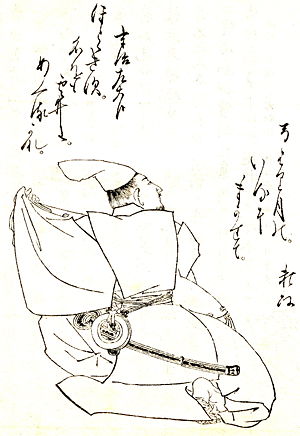
Minamoto no Yorimasa
Encyclopedia

was a prominent Japan
Japan
Japan is an island nation in East Asia. Located in the Pacific Ocean, it lies to the east of the Sea of Japan, China, North Korea, South Korea and Russia, stretching from the Sea of Okhotsk in the north to the East China Sea and Taiwan in the south...
ese poet whose works appeared in various anthologies
Anthology
An anthology is a collection of literary works chosen by the compiler. It may be a collection of poems, short stories, plays, songs, or excerpts...
. He served eight different emperors in his long career, holding posts such as hyōgo no kami (head of the arsenal). He was also a warrior, leading the Minamoto
Minamoto clan
was one of the surnames bestowed by the Emperors of Japan upon members of the imperial family who were demoted into the ranks of the nobility. The practice was most prevalent during the Heian Period , although its last occurrence was during the Sengoku Era. The Taira were another such offshoot of...
armies at the beginning of the Genpei War
Genpei War
The was a conflict between the Taira and Minamoto clans during the late-Heian period of Japan. It resulted in the fall of the Taira clan and the establishment of the Kamakura shogunate under Minamoto Yoritomo in 1192....
.
In the clashes between the Minamoto and Taira clans that had gone on for decades, Yorimasa had tried to stay out of politics, and avoided taking sides. He did participate in the Hogen Rebellion in 1156. For a time, he was even friends with Taira no Kiyomori
Taira no Kiyomori
was a general of the late Heian period of Japan. He established the first samurai-dominated administrative government in the history of Japan.After the death of his father Taira no Tadamori in 1153, Kiyomori assumed control of the Taira clan and ambitiously entered the political realm in which he...
. During the Heiji Rebellion
Heiji Rebellion
The was a short civil war fought in order to resolve a dispute about political power. The Heiji no ran encompassed clashes between rival subjects of the cloistered Emperor Go-Shirakawa of Japan in 1159. It was preceded by the Hōgen Rebellion in 1156...
of 1160, he leaned just enough in favor of the Taira that it allowed them to overthrow the Minamoto. However, by the time he officially retired from military service in Kiyomori's army in 1179, Yorimasa had changed his mind about opposing his own clan. He entered the Buddhist priesthood. In May of 1180, he sent out an appeal to other Minamoto leaders, and to temples and monasteries that Kiyomori had offended.
The Genpei War
Genpei War
The was a conflict between the Taira and Minamoto clans during the late-Heian period of Japan. It resulted in the fall of the Taira clan and the establishment of the Kamakura shogunate under Minamoto Yoritomo in 1192....
began with the Battle of Uji
Battle of Uji (1180)
The first battle of Uji is famous and important for having opened the Genpei War.In early 1180, Prince Mochihito, the Minamoto Clan's favored claimant to the Imperial Throne, was chased by Taira forces to the Mii-dera, a temple just outside Kyoto....
in 1180. Yorimasa led Minamoto forces, along with warrior monks
Sohei
were Buddhist warrior monks of feudal Japan. At certain points of history they held considerable power, obliging the imperial and military governments to collaborate....
from Mii-dera
Mii-dera
', formally called ', is a Buddhist temple located at the foot of Mount Hiei, in the city of Ōtsu, in Shiga Prefecture. It is only a short distance from both Kyoto, and Lake Biwa, Japan's largest lake. The head temple of the Tendai Jimon sect, it is something of a sister temple to Enryakuji, at...
, in defending the Byōdō-in
Byodo-in
is a Buddhist temple in the city of Uji in Kyoto Prefecture, Japan. It is jointly a temple of the Jōdo-shū and Tendai-shū sects.- History :...
. Despite the monks' having torn up the planks of the bridge leading to the temple, the Taira managed to break through the defenses, and take the temple. Suffering defeat at Uji, he committed suicide in the Byōdō-in. Minamoto no Yorimasa's ritual suicide by seppuku
Seppuku
is a form of Japanese ritual suicide by disembowelment. Seppuku was originally reserved only for samurai. Part of the samurai bushido honor code, seppuku was either used voluntarily by samurai to die with honor rather than fall into the hands of their enemies , or as a form of capital punishment...
is the earliest recorded instance of a samurai's suicide in the face of defeat.
According to legend, his retainer took his head to prevent it from falling into the hands of the Taira. He then fastened his master's head to a rock and threw it into the Uji River so it could not be found.
Yorimasa's death poem
Death poem
A death poem is a poem written near the time of one's own death. It is a tradition for literate people to write one in a number of different cultures, especially in Joseon Korea and Japan.-History:...
was:
- umoregi no/hana saku koto mo/nakarishi ni/mi no naru hate zo/kanashikarikeru
- Like an old tree
- From which we gather no blossoms
- Sad has been my life
- Fated to bear no fruit

